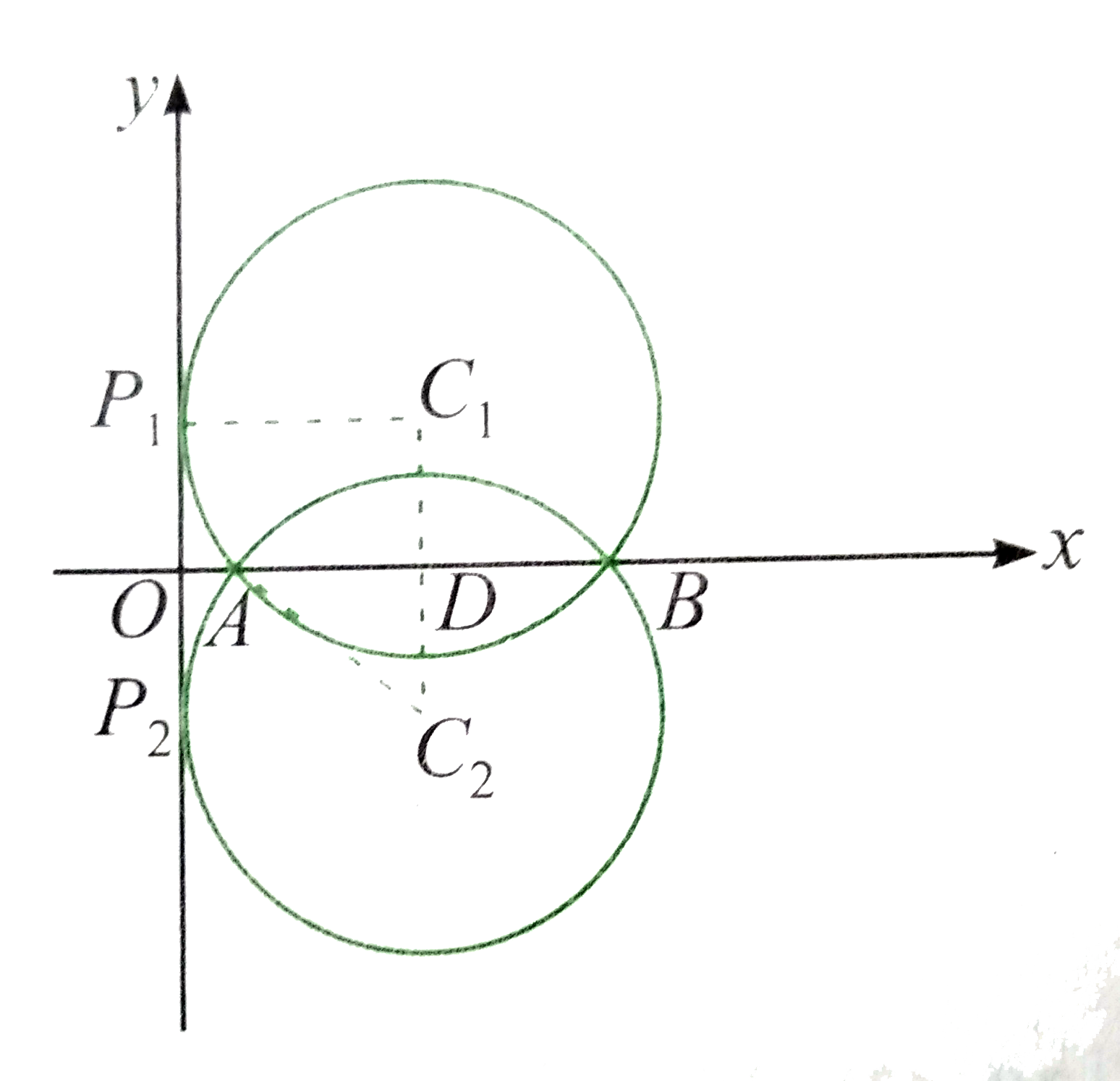The circle which can be drawn to pass through (1, 0) and (3, 0) and to touch the y-axis intersect at angle θ. Then cosθ is equal to (a)12 (b) −12 (c) 14 (d) −14Solution in Tamil
1/2
1/3
1/4
−1/4
The correct Answer is:1
Let A≡(1,0),B≡(3,0) and C1 and C2 be the centers of circles passing through A and Band touching the y-axis at P1 and P2 respectively. If r is the radius ( here radii of both circles will be the same ).
C1A=C2A=r=OD=2
and C1=(2,h)
or C1≡(2,√3),C2≡(2,−√3)
If ∠C1AC2=θ, then
cosθ=AC21+AC22−C1C222AC1×AC2=12

Topper's Solved these Questions
- CIRCLE BOOK - CENGAGECHAPTER - CIRCLE EXERCISE - Exercise (Multiple)
25 Videos
- CIRCLE BOOK - CENGAGECHAPTER - CIRCLE EXERCISE - Exercise (Comprehension)
46 Videos
- CIRCLE BOOK - CENGAGECHAPTER - CIRCLE EXERCISE - Exercise 4.6
5 Videos
- BINOMIAL THEOREMBOOK - CENGAGECHAPTER - BINOMIAL THEOREMEXERCISE - Comprehension
11 Videos
- CIRCLESBOOK - CENGAGECHAPTER - CIRCLESEXERCISE - Question Bank
16 Videos
Similar Questions
about to only mathematics
View SolutionEach side of a square is of length 6 units and the centre of the square Is ( - 1, 2). One of its diagonals is parallel to x+y=0. Find the co-ordinates of the vertices of the square.
View SolutionIf the circle x2+y2+2x+3y+1=0 cuts x2+y2+4x+3y+2=0 at AandB , then find the equation of the circle on AB as diameter.
View SolutionConsider a G.P. with first term (1+x)n, |x|<1, common ratio 1+x2 and number of terms (n+1). Let 'S' be sum of all the terms of the G.P., then
The coefficient of xn is 'S' is
View SolutionIf ax+by=10 is the chord of minimum length of the circle (x−10)2+(y−20)2=729 and the chord passes through (5,15) then the value of (4a+2b) is
View SolutionLet C be the circle with centre at (1, 1) and radius = 1. If T is the circle centred at (0, y), passing through origin and touching the circle C externally, then the radius of T is equal to (1) √3√2 (2) √32 (3) 12 (3) 14
View SolutionThe circle which can be drawn to pass through (1, 0) and (3, 0) and to touch the y-axis intersect at angle θ. Then cosθ is equal to (a)12 (b) −12 (c) 14 (d) −14
View SolutionIf the circles x2+y2−9=0 and x2+y2+2ax+2y+1=0 touch each other, then α is −43 (b) 0 (c) 1 (d) 43
View SolutionIf a circle touches y-axis at (0, 4) and passes through (2, 0) then which of the following can not be the tangent to the circle
View SolutionA circle passing through (1,1) and (3,3) intersect the positive x -axis at A(a,0) and B(b,0) .Then ab=?
View SolutionA circle passing through (1,1) and (3,3) intersect the positive x -axis at A(a,0) and B(b,0) .Then ab=?
View SolutionThe circles which can be drawn to pass through (3,0) and (5,0) and to touch the y-axis intersect at an angle θ , then cosθ is equal to
View SolutionThe circle which can be drawn to pass through (1, 0) and (3, 0) and to touch the y-axis intersect at angle θ. Then cosθ is equal to (a)12 (b) −12 (c) 14 (d) −14
View SolutionIf the circles x2+y2−9=0 and x2+y2+2αx+2y+1=0 touch each other, then α is (a)−43 (b) 0 (c) 1 (d) 43
View SolutionIf the circles x2+y2−9=0 and x2+y2+2ax+2y+1=0 touch each other, then a is −43 (b) 0 (c) 1 (d) 43
View SolutionLet C be the circle with centre at (1, 1) and radius = 1. If T is the circle centred at (0, y), passing through origin and touching the circle C externally, then the radius of T is equal to (1) √3√2 (2) √32 (3) 12 (3) 14
View Solution
